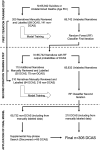A Data Science Approach to Estimating the Frequency of Driving Cessation Associated Suicide in the US: Evidence From the National Violent Death Reporting System
- PMID: 34485220
- PMCID: PMC8415628
- DOI: 10.3389/fpubh.2021.689967
A Data Science Approach to Estimating the Frequency of Driving Cessation Associated Suicide in the US: Evidence From the National Violent Death Reporting System
Abstract
Driving cessation is a common transition experienced by aging adults that confers both a symbolic and literal loss of independence due to the central role of automobiles for mobility in the US. Prior research has shown that driving cessation has negative implications for mental health, social participation, and access to healthcare. Given these sequelae of driving cessation and prior work showing that late-life transitions related to independence (e.g., transitioning into residential care) are associated with suicide, we sought to estimate the frequency of driving cessation associated suicide. Data include suicide (n = 59,080) and undetermined (n = 6,862) deaths aged ≥55 from the National Violent Death Reporting System (NVDRS, 2003-2017). Each case in the NVDRS has both quantitative data (e.g., demographic characteristics) and qualitative text narratives, derived from coroner/medical examiner reports, which describe the most salient circumstances and features of each death. To identify cases associated with driving cessation, we employed a supervised random forest algorithm to develop a Natural Language Processing (NLP) classifier. Identified driving cessation associated cases were then categorized and characterized using descriptive statistics and qualitative content analysis. From 2003 to 2017, there were an estimated 305 cases of suicide/undetermined deaths associated with driving cessation in the NVDRS, representing 0.04% of all cases. Cases associated with driving cessation were older, more likely to be male, more likely to have a physical health problem, more likely to have experienced a recent crisis, and more likely to have lived in a rural county than other decedents. Qualitative analysis identified functional impairment, alcohol-related driving limitations, loss of employment, and recent car accidents as common themes among cases associated with driving cessation. This analysis illustrates the utility of NLP in identifying novel correlates of suicide in later life. Although driving cessation associated suicide is a rare outcome, further research is warranted on understanding the conditions under which driving cessation is associated with suicidal behavior, and how to support the well-being of aging adults during these types of major life transitions.
Keywords: aging; driving cessation; machine learning; natural language processing; suicide.
Copyright © 2021 Ko, Kalesnikava, Jurgens and Mezuk.
Conflict of interest statement
The authors declare that the research was conducted in the absence of any commercial or financial relationships that could be construed as a potential conflict of interest.
Figures

Similar articles
-
Surveillance for Violent Deaths - National Violent Death Reporting System, 50 States, the District of Columbia, and Puerto Rico, 2022.MMWR Surveill Summ. 2025 Jun 12;74(5):1-42. doi: 10.15585/mmwr.ss7405a1. MMWR Surveill Summ. 2025. PMID: 40493548 Free PMC article.
-
Surveillance for Violent Deaths - National Violent Death Reporting System, 48 States, the District of Columbia, and Puerto Rico, 2020.MMWR Surveill Summ. 2023 May 26;72(5):1-38. doi: 10.15585/mmwr.ss7205a1. MMWR Surveill Summ. 2023. PMID: 37220104 Free PMC article.
-
Antidepressants for pain management in adults with chronic pain: a network meta-analysis.Health Technol Assess. 2024 Oct;28(62):1-155. doi: 10.3310/MKRT2948. Health Technol Assess. 2024. PMID: 39367772 Free PMC article.
-
A New Measure of Quantified Social Health Is Associated With Levels of Discomfort, Capability, and Mental and General Health Among Patients Seeking Musculoskeletal Specialty Care.Clin Orthop Relat Res. 2025 Apr 1;483(4):647-663. doi: 10.1097/CORR.0000000000003394. Epub 2025 Feb 5. Clin Orthop Relat Res. 2025. PMID: 39915110
-
Effectiveness and cost-effectiveness of computer and other electronic aids for smoking cessation: a systematic review and network meta-analysis.Health Technol Assess. 2012;16(38):1-205, iii-v. doi: 10.3310/hta16380. Health Technol Assess. 2012. PMID: 23046909
Cited by
-
A Critical Review of Text Mining Applications for Suicide Research.Curr Epidemiol Rep. 2022;9(3):126-134. doi: 10.1007/s40471-022-00293-w. Epub 2022 Jul 26. Curr Epidemiol Rep. 2022. PMID: 35911089 Free PMC article. Review.
-
Understanding Suicide over the Life Course Using Data Science Tools within a Triangulation Framework.J Psychiatr Brain Sci. 2023;8(1):e230003. doi: 10.20900/jpbs.20230003. Epub 2023 Mar 2. J Psychiatr Brain Sci. 2023. PMID: 37168035 Free PMC article.
-
Association of driving while intoxicated and suicide ideation and attempts in South Korea: a study in a nationally representative sample.Sci Rep. 2023 Aug 30;13(1):14199. doi: 10.1038/s41598-023-40829-8. Sci Rep. 2023. PMID: 37648687 Free PMC article.
-
Stakeholder perspectives on vision screening for drivers in Gauteng: Policy review implications.Health SA. 2025 Feb 21;30:2826. doi: 10.4102/hsag.v30i0.2826. eCollection 2025. Health SA. 2025. PMID: 40062348 Free PMC article.
-
Research utility and limitations of textual data in the National Violent Death Reporting System: a scoping review and recommendations.Inj Epidemiol. 2023 May 9;10(1):23. doi: 10.1186/s40621-023-00433-w. Inj Epidemiol. 2023. PMID: 37161610 Free PMC article.
References
-
- Hedegaard H, Curtin S, Warner M. Increase in suicide mortality in the United States, 1999-2018. CDC NCHS Data Brief. (2020) 362. Available online at: https://stacks.cdc.gov/view/cdc/86670 (accessed March 3, 2021). - PubMed
-
- National Center for Injury Prevention and Control . Web-based Injury Statistics Query and Reporting System (WISQARS). (2005). Available online at: www.cdc.gov/injury/wisqars (accessed March 14, 2021).
-
- Covinsky KE, Palmer RM, Fortinsky RH, Counsell SR, Stewart AL, Kresevic D, et al. Loss of independence in activities of daily living in older adults hospitalized with medical illnesses: increased vulnerability with age. J Am Geriatr Soc. (2003) 51:451–8. 10.1046/j.1532-5415.2003.51152.x - DOI - PubMed
Publication types
MeSH terms
Grants and funding
LinkOut - more resources
Full Text Sources
Medical

